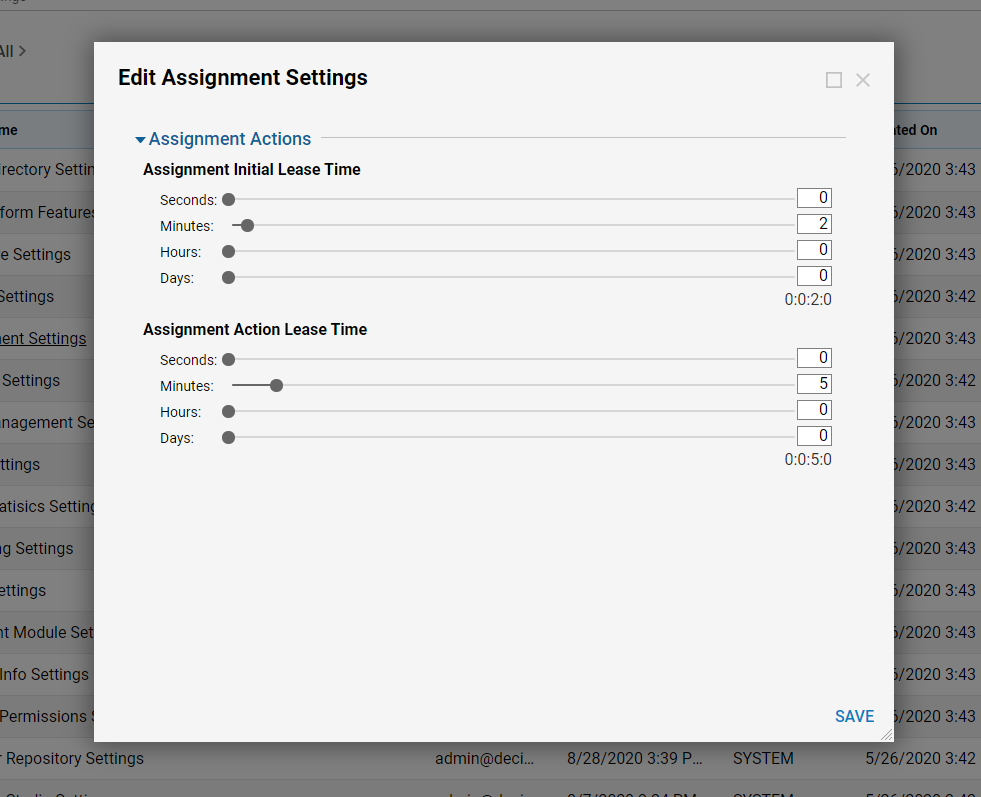Overview
To assign specific users or Groups with pre-defined actions via Assignments, Designers are offered a host of customizable options that define how an Assignment is sent, who it is sent To and From, and what sort of task is sent. This article reviews these settings, configured both within the Flow Designer and in the Portal via the System Folder, used to establish parameters for an Assignment.
Assignment Properties (In Flow)
The Properties tab on an Assignment acts as home to the multitude of available configurations that are available in the Flow Designer. From the initial Assignment panel of the Properties tab, the user is presented with some basic configurations regarding Assignments. The table below explains how these Properties function.
| Input | Function |
|---|---|
| Assign To | Used to define who the Assignment is is assigned to. This could be a user, group, etc... |
| Assignment Name | Used to define the name of the Assignment. |
| Assignment Action Name | Used to define the name of the Assignment's Action itself. |
| Assignment Reference Id | Used as a means to reference the Assignment. |
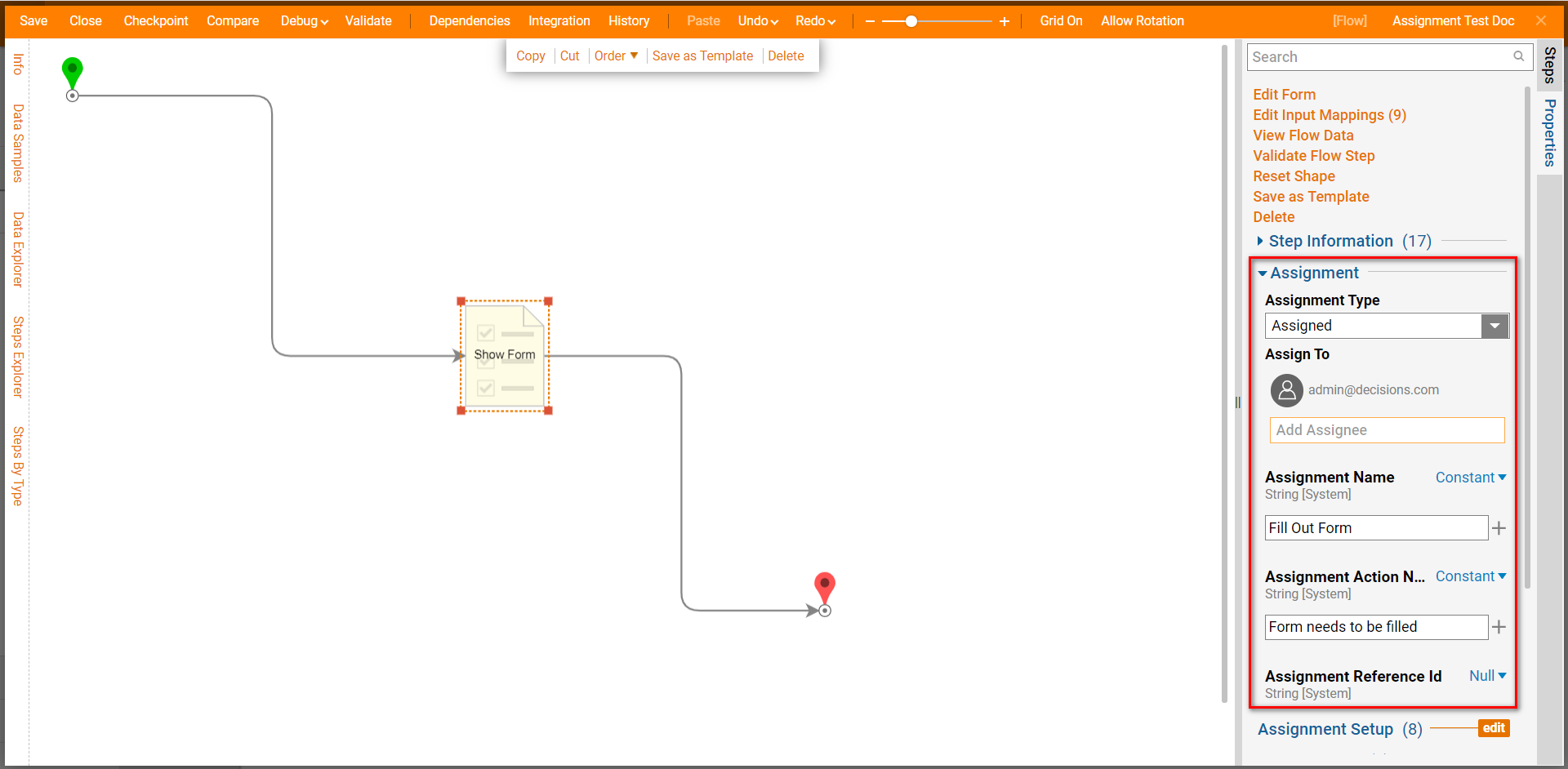 Assignment Setup
Assignment Setup
In addition to the standard Assignment Properties such as Assignment Type, made available in the Assignment panel, Assignments contain a multitude of other configurable features that can be found under Assignment Setup. The Inputs in this window contain several subcategories, the first being From Data.
From Data
These features allow users to define which Accounts, Groups, or Roles act as the point of origin for the Assignment. These are the Accounts and Groups, Assignment Roles, and Exclude Accounts and Groups Inputs.
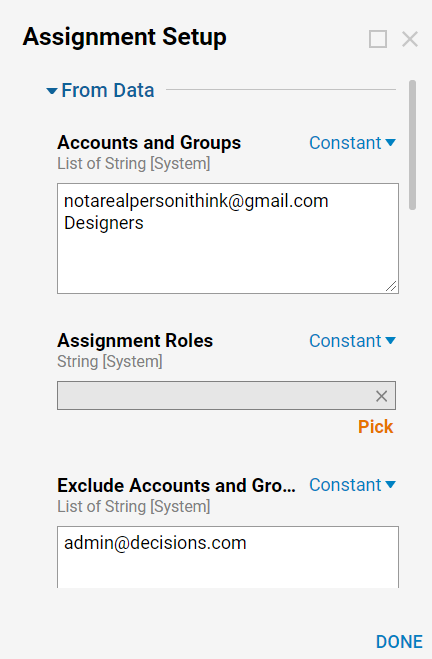
Assignment Data
The next group of Inputs in the Assignment Setup panel is the Assignment Data group. These Inputs allow the user to define parameters specific to the Data being used in the Assignment.
Utilizing the Assignment Folder Type drop down allows users the ability to configure the Folder where the Assignment is stored. The drop down provides three options as configurations:
| Name | Function |
| NotSpecified | Does not store the Assignment in a specific Folder. |
| Select | Allows the user the ability to define where the Assignment is stored via the Folder Picker. |
| FromFlow | Allows the user to pass the Assignment storage location from Flow via a Folder ID. Selecting this option will display the new Assignment Folder Id Input. |
The remaining Inputs pertaining to the Assignment Data behave as follows:
| Name | Function |
|---|---|
| Assignment Description | String Input used to give the Assignment a Description. |
| Assignment Type Description | String Input used to designate a Description for the Assignment's Type. |
| Assignment Priority | A String Input used to assign a Priority level to the Assignment. |
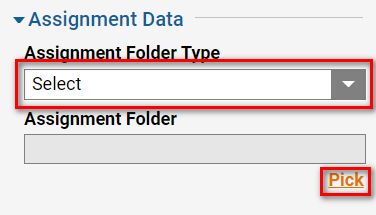

Additional Setup
The Assignment Setup panel offers further configurations beyond the Assignment Data; one of which is the Show Assigned Form drop down underneath the Automatically Show if Assigned header. The drop down offers the user the option to Show the Form Never, Always, Dynamically, or to Suggest it.
After establishing the Show Assigned Form setting, users may Input specific action Dates; these Dates include the following which are toggled via boolean:
| Specify Start Date | Establishes the Start Date for the Assignment. |
| Specify Warn Date | Establishes when to Warn the user about the Assignment completion. |
| Specify Late Date | Establishes when the Assignment is considered Late. |
| Specify Escalate Date | Establishes when escalation actions will be taken against the Assignment. |
| Specify Expiration Date | Establishes when the Assignment expires. |
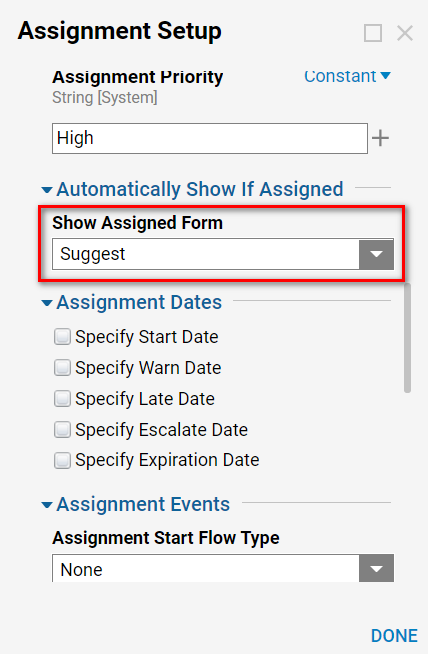
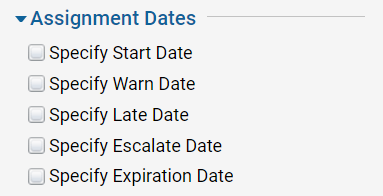
Assignment Events
The next category in the panel is the Assignment Events settings. These settings allow users to establish Flow behavior for the Start, Warn, Late, and Escalate Flow for an Assignment. This Input exists in the form of a drop down menu that offers three options which behave as follows:
| Name | Function |
| None | Does not a specific Flow or behavior for the Assignment at the respective State of the Assignment. |
| SharedFlow | Does not allow Flow Data from the Parent Flow, but is reusable in other Assignments. |
| Private | Can pull data from the Parent Flow, but are tied to a specific Assignment and are not reusable. |
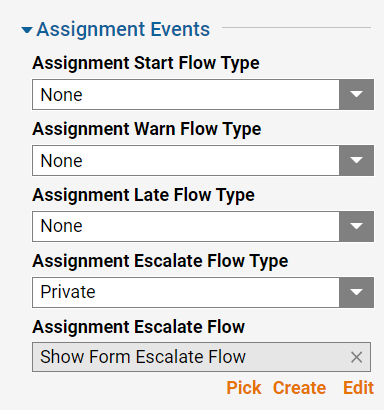
Reuse Assignment
The next category of Assignment Setup options pertains to Reuse behavior for Assignments. The initial Reuse Assignment drop down offers three options for reusing the Assignment; No, which disables Reuse on the Assignment, Always which always enables Reuse of the Assignment, and If Same Assignee, which only reuses the assignment upon receival by the same Assignee.
This category also provides additional behaviors that are triggered via checkbox which behave as follows:
| Rerun Startup Flow | Reruns the Startup Flow upon Reuse of the Assignment. |
| Resend Email | Resends the Email upon Reuse of the Assignment. |
| Calculate New Assignment Dates | Allows the ability to Calculate New Assignment Dates on Reuse of the Assignment. |
| Keep Existing Assignment Description | Maintains the same Assignment Description upon Reuse of the Assignment. |
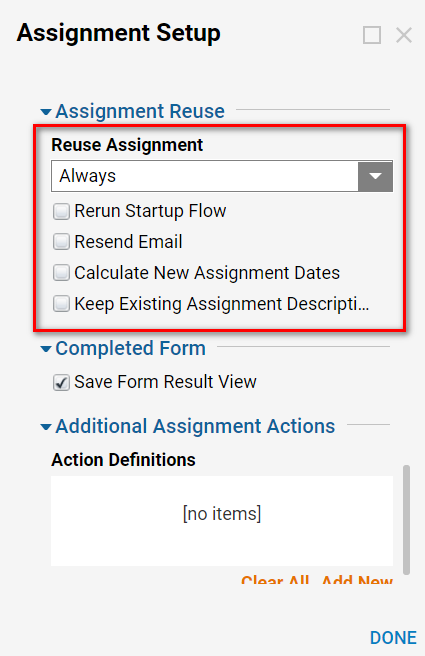
The final subsection of Assignment Setup Properties exist in the Additional Assignment Actions Inputs. These settings allow users to define additional specific Actions (such as Approvals and Denials).
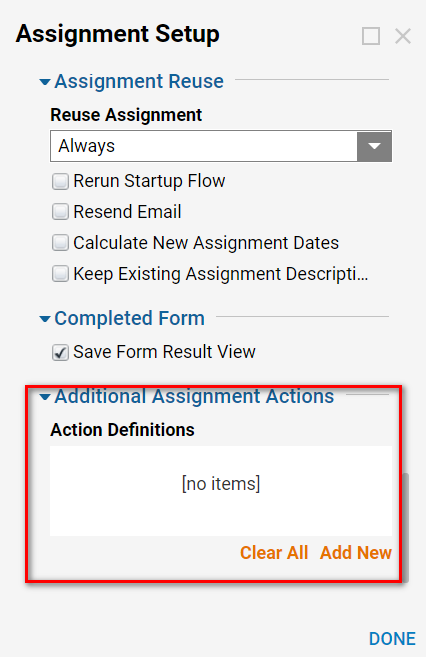
.png)
On Step Run and Auto Complete Step
Assignments offer additional options for Assignment behavior regarding behaviors that occur when the Assigned Flow runs the step. Underneath the On Step Run section users may define the Step Start Flow Type as either None, SharedFlow, or Private. Triggering one of these options will allow the user to define which Flow to Run and a number of Parameters for that Flow and the Assignment's Process.
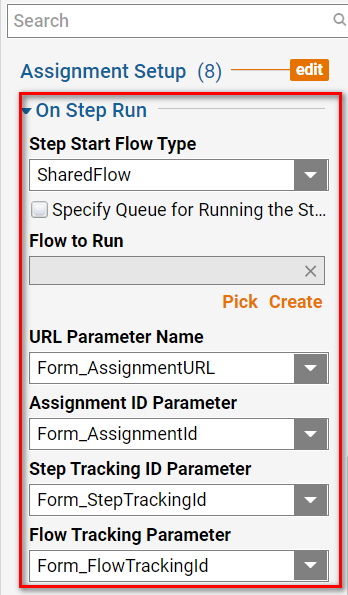
The Auto Complete Step panel is used to set the step to complete on its own based on a set Time definition, in addition to its behavior upon completion.
Users define those Outcome behaviors via the Scenarios [Additional Outcomes for AutoComplete] Input and the Auto Complete Time via the Check Time Span sliders.
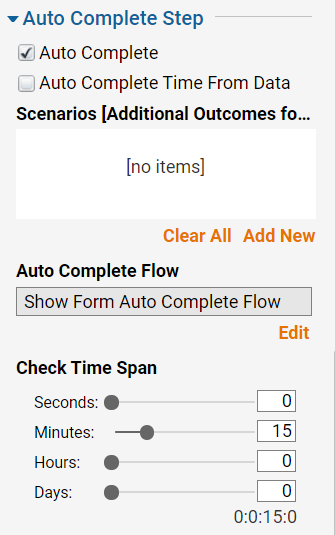
If a user wishes to dynamically Input the Auto Complete Time, they may opt to check the Auto Complete Time From Data boolean.

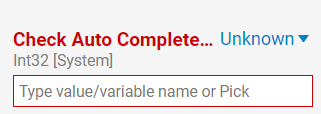
Form Setup
When utilizing responding to an Assignment from another platform (such as web, mobile, tablet) an administrator may want the Assignee to see the Form displayed in a different format, or maybe even an entirely different Form altogether. By using the Form Setup Properties, users may Pick, Create, or Edit a different Form depending on which platform they are accessing the Assignment from.
Defining a Form for each platform will provide the Designer with alternate paths that they may use to route the results of the Assignment to a different outcome if desired.
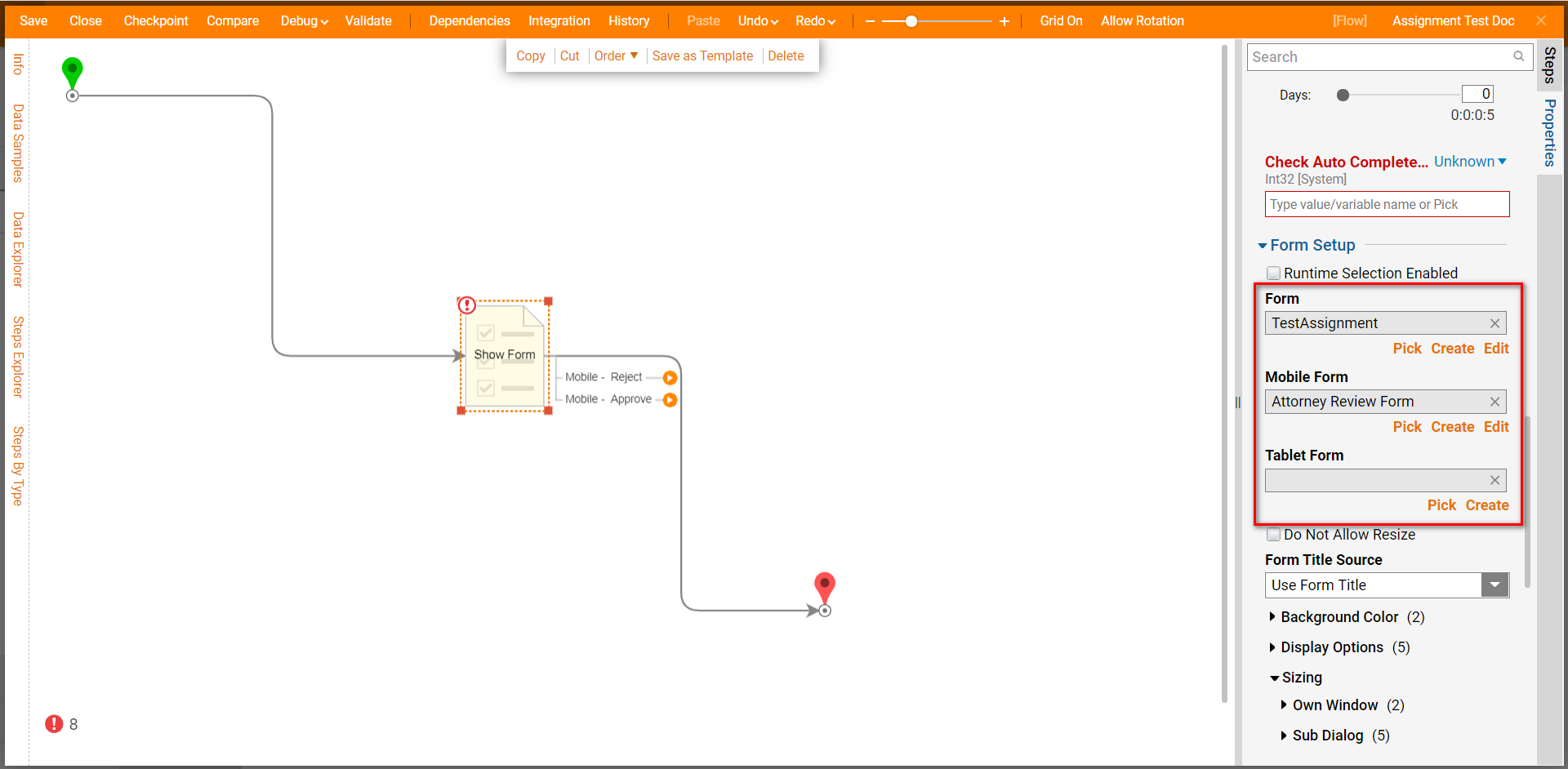
Assignment Settings (System)
In addition to the Assignment Properties options that can be used directly within a Flow, the Portal offers further configurations that may be adjusted by navigating to System -> Settings -> Assignment Settings.
| Assignment Action Category Name | Function |
Assignment Initial Lease Time | The time that the lease on the assigned form session is good for after a user opens it |
Assignment Action Lease Time | The amount of time before another user can use the context/right-click action for the assignment |
